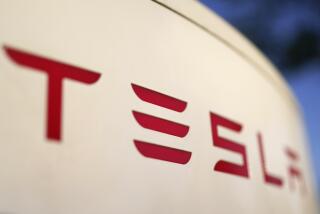GM Ordered to Pay $15.4 Million to SUV Crash Victim
- Share via
A San Bernardino County Superior Court jury Friday ordered General Motors Corp. to pay more than $15 million to a South Bay man who became a quadriplegic in a rollover crash of a Chevy S-10 Blazer.
The verdict in the Rancho Cucamonga trial, which highlighted the dangers of weak roofs in rollover-prone sport-utility vehicles, capped a lengthy retrial of the suit brought by Robbie Lambert, 29, of Torrance, who suffered paralyzing injuries in the wreck in July 1990.
Ruling that the Blazer was defectively designed due to the weakness of its roof, the jury set Lambert’s damages at $25.7 million--but found him 40% responsible for his injuries, paring the award to $15.4 million.
His lawyer, Michael Piuze, said after the verdict that under state law, Lambert’s award automatically will be increased to $18.3 million with interest accrued from the date GM spurned a settlement offer.
Lambert was 18 and an amateur hockey star at the time of the crash. Returning from a camping trip, he apparently fell asleep at the wheel, allowing the Blazer to drift off the highway in San Bernardino County and flip over. Lambert was wearing a safety belt, but the roof of the Blazer crushed inward in the crash, leaving him paralyzed.
“I feel very blessed that the jury came back in my favor,” Lambert said.
GM lawyer Vincent Galvin said he was disappointed by the outcome, adding that evidence showed that Lambert’s injuries would have been just as severe if the roof had not caved in. He said it was uncertain if GM will appeal.
Rollover crashes last year caused more than 10,000 deaths in the U.S., along with thousands of severe brain and spinal cord injuries. The body count has risen with the growing popularity of top-heavy SUVs and other light trucks, which are two to three times more rollover-prone than passenger cars. Safety advocates maintain that many of these casualties would be avoided if the roofs were stronger.
During the trial, which began in late September, Piuze argued that vehicle roofs could be made significantly stronger with a few extra pounds of steel.
“With the advent of SUVs, the problem of unnecessarily weak roofs has become much greater,” Piuze said following the verdict. “The manufacturers obviously find it cheaper to pay off these judgments when they occur, one at a time, rather than . . . redesign the roofs.”
While finding GM liable for a defective design, the jury rejected a claim that the company was negligent for failing to recall and strengthen Blazer roofs. It also found the auto maker was not liable for punitive damages.
It was Lambert’s second victory over GM in a legal battle that has lasted more than a decade.
In the original trial in 1992, jurors awarded Lambert $7.5 million--setting damages at $15 million but finding him 50% responsible. But a state appeals court in 1996 found the verdict internally inconsistent and ordered a new trial. Piuze said GM two years ago rejected an offer to settle the case for $7.5 million.
Vehicle manufacturers--who can shave costs and boost fuel economy by limiting the thickness of steel in the roofs--generally claim that roof strength has little bearing on the number or severity of rollover injuries.
They argue that even with safety belts, occupants fall head-first into the roof when vehicles flip over. Thus, they maintain, the injuries probably will be the same whether the roof caves in or remains intact.
GM has been a leading exponent of this “roof dive” theory. Piuze spent much of the trial attacking GM studies that underpin the theory.
The government’s minimum standard for roof strength is widely considered to be extremely weak, and vehicle safety regulators say stronger roofs would reduce injuries and save lives. In 1994, the National Highway Traffic Safety Administration said it was considering upgrading the roof crush standard, but has yet to strengthen the requirement.






